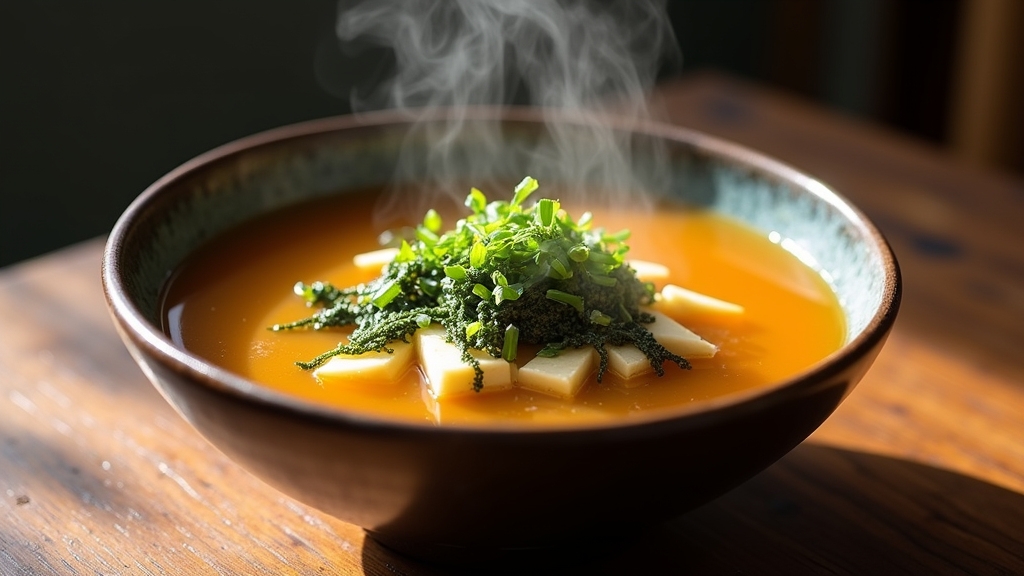If you’re looking for an easy miso soup recipe, you’re in for a treat! I like to start with 4 cups of warm dashi or water, adding 3 tablespoons of miso paste. Then, I toss in cubes of silken tofu and rehydrated wakame seaweed. Simmer for just five minutes to blend flavors without boiling. It’s nutritious, packed with flavor, and completely customizable. Keep going to discover how to elevate your miso soup experience!
History
Miso soup, a beloved staple of Japanese cuisine, has a rich history that dates back over a thousand years. I find it fascinating how this humble dish evolved from simple fermented soybeans into a culinary symbol of Japan. Originally introduced by Buddhist monks, miso became integral to the Japanese diet, embodying nourishment and community. Its cultural significance extends beyond mere sustenance; it represents harmony and tradition in Japanese households. Each bowl tells a story, reflecting regional variations and personal touches that make it unique. As I savor each spoonful, I appreciate not just the flavors but also the deep-rooted heritage that miso soup carries, reminding us of the innovation that can arise from centuries of culinary artistry and cultural exchange.
Recipe
Miso soup is a traditional Japanese dish that embodies simplicity and depth of flavor. Often served as a starter in Japanese meals, this comforting soup is not only nourishing but also quick to prepare. The primary ingredients include miso paste, dashi (a Japanese soup stock), and a variety of vegetables or proteins, making it a versatile dish that can be tailored to personal preferences. The flavors of the soup can be enhanced with toppings such as green onions, tofu, and seaweed, contributing to its rich umami profile.
To create a delicious bowl of miso soup, you’ll need to focus on the quality of your ingredients, especially the miso paste and dashi. Miso paste can vary in color and flavor, with white miso being sweeter and red miso having a more robust taste. It’s important to balance the flavors and find the right combination that suits your palate. Once you have your ingredients ready, the cooking process is straightforward, making this a perfect dish for both novice and experienced cooks.
Ingredients:
- 4 cups dashi or water
- 3 tablespoons miso paste (white, yellow, or red)
- 1 cup silken or firm tofu, cubed
- 1 cup wakame seaweed (dried)
- 2 green onions, sliced
- Optional: mushrooms, spinach, or other vegetables
Cooking Instructions:
In a pot, bring the dashi or water to a gentle simmer. Add the dried wakame seaweed and let it rehydrate for a few minutes until it becomes tender. Next, add the cubed tofu and any additional vegetables you choose to include. Once the ingredients are heated through, take a ladle of the warm broth and mix it with the miso paste in a separate bowl until smooth. Gradually stir the miso mixture back into the pot, making certain that it doesn’t boil, as high heat can destroy the beneficial properties of miso. Remove from heat and garnish with sliced green onions before serving.
Extra Tips:
When preparing miso soup, remember that miso paste is quite salty, so adjust the amount based on your taste preferences. It’s best to add the miso at the end of cooking to preserve its flavor and nutrition. Experiment with different types of miso and toppings to discover your perfect combination. Additionally, if you want to make a vegetarian version, confirm that your dashi is vegetable-based or use water with added umami flavors like mushrooms or kombu. Enjoy your homemade miso soup!
Cooking Steps
Let’s get started on making this comforting miso soup! First, I’ll gather all the ingredients to guarantee a smooth cooking process. Then, I’ll walk you through each step, from adding the dashi broth to that satisfying simmer at the end.
Step 1. Gather All Ingredients Needed
Before diving into the cooking process, I make sure to gather all the ingredients needed for a delicious bowl of miso soup. First, I select high-quality miso paste—white for a lighter flavor or red for a bolder taste. Next, I grab some dashi broth, which serves as the soup’s foundational flavor profile. Fresh tofu adds a creamy texture, while vibrant green onions bring a pop of color and freshness. I also pick up seaweed, like wakame, for an umami kick. Finally, I’m never without mushrooms, as they deepen the flavor experience. With my ingredient selection complete, I’m ready to create a savory, comforting dish that’s both innovative and heartwarming. Let’s get cooking!
Step 2. Add Dashi Broth to Pot
With all my ingredients ready, I move on to the exciting part: adding the dashi broth to the pot. This is where the magic begins, as the rich umami flavors start to meld. I’ve experimented with various dashi variations, and each one brings something unique to the table.
Here’s what to keep in mind:
- Type of Dashi: Whether it’s kombu, bonito, or a vegetarian option, each broth type has its own character.
- Temperature: Make sure the pot is warm but not boiling to preserve the delicate flavors.
- Timing: Allow the dashi to simmer for a few minutes, letting those incredible flavors develop fully.
This step sets the foundation for a truly delightful miso soup!
Step 3. Add Miso Paste Thoroughly
As the dashi simmers gently, it’s time to incorporate the miso paste, which is the heart of the soup. I like to take a small bowl and mix a few spoonfuls of miso with a ladle of hot dashi, creating a smooth, velvety mixture. This step guarantees a consistent flavor throughout. You can experiment with different miso variations—white for a milder, sweeter taste or red for a more robust, umami punch. As I pour the blended miso back into the pot, I’m excited to see how it transforms the flavor profiles, adding depth and richness. Stir it well, and allow it to warm through—never boil, as that can dull the vibrant taste. Enjoy the aromatic journey!
Step 4. Add Tofu and Seaweed
Once I’ve blended the miso into the dashi, I enthusiastically add the tofu and seaweed, both essential ingredients that elevate the soup’s texture and flavor. Tofu not only provides a creamy consistency but also packs a protein punch, making it a fantastic addition for health-conscious eaters. I love exploring different seaweed varieties, as they bring unique tastes and nutrients to the dish. Here’s how I incorporate them:
- Tofu: I cut it into bite-sized cubes, ensuring it absorbs the broth’s rich flavor.
- Seaweed: I opt for wakame or nori, adding a delightful umami taste and essential minerals.
- Presentation: I sprinkle a few green onions on top for a fresh, vibrant finish.
These additions truly transform my miso soup!
Step 5. Simmer for Five Minutes
Now it’s time to let the flavors meld together, so I gently cover the pot and simmer the soup for five minutes. This step is essential, as those simmer techniques allow the ingredients to release their essence, creating a harmonious blend. I can almost smell the umami wafting through the kitchen! During this short but transformative period, the tofu absorbs the savory broth, while the seaweed adds its subtle depth. It’s fascinating how just a few minutes of simmering can lead to such flavor enhancement. I keep an eye on the pot, ensuring it doesn’t boil too vigorously—gentle bubbles are what we want. After five minutes, I know the soup is ready to serve, bursting with rich, layered tastes.
Nutritional Guide
Since miso soup is not just a comforting dish but also a powerhouse of nutrition, it’s worth exploring its health benefits. This soup is rich in nutrients with impressive nutrient density, making it a fantastic addition to your diet. Here’s a quick look at some of its key components:
| Nutrient | Health Benefits | Source |
|---|---|---|
| Protein | Supports muscle growth | Miso, tofu |
| Vitamins B & K | Boosts energy, aids healing | Seaweed, green onions |
| Probiotics | Enhances gut health | Fermented miso |
| Antioxidants | Reduces oxidative stress | Miso, dashi broth |
| Minerals | Supports bone health | Miso, seaweed |
With every bowl, you’re not just savoring flavors; you’re fueling your body!
Final Thoughts
Miso soup isn’t just a delightful blend of flavors; it’s also a nourishing staple that brings numerous health benefits to the table. When I make it, I love how versatile this dish can be. Here are some serving suggestions that elevate the experience:
- Add Tofu: Incorporating silken tofu enhances protein content and creates a creamy texture.
- Toss in Seaweed: Wakame or nori not only adds a umami kick but also boosts the soup’s mineral profile.
- Garnish with Green Onions: Freshly chopped green onions provide a vibrant crunch and a pop of flavor.
With its rich taste and health benefits, miso soup is a wonderful addition to any meal. I can’t wait for you to try it!
Frequently Asked Questions
Can I Use Instant Miso Paste for This Recipe?
Absolutely, I love using instant miso! It’s convenient, but I’ve noticed some flavor differences compared to traditional paste. If you’re craving that authentic taste, consider blending instant with fresh ingredients for a richer experience.
What Type of Tofu Is Best for Miso Soup?
When I make miso soup, I love using soft tofu for its delicate texture, but firm tofu adds a satisfying bite. Both enhance the dish, so it really depends on what you’re craving that day!
How Long Does Miso Soup Last in the Fridge?
Did you know miso soup can stay fresh in the fridge for up to three days? I always store mine properly to maintain its delicious flavor, ensuring my miso storage keeps that comforting warmth alive!
Can I Add Vegetables to Miso Soup?
I love experimenting with vegetable combinations in my miso soup. Carrots, spinach, and mushrooms create delightful flavor variations, enhancing the dish’s depth and nutrition. Don’t hesitate to get creative with your fresh produce!
Is Miso Soup Gluten-Free?
When I savor a warm bowl of miso soup, I wonder about its ingredients. Most miso types, like white and yellow, are gluten-free, but always check labels—some soup variations use wheat for added flavor.
Conclusion
As I savor the warm, umami-rich broth of my homemade miso soup, I can’t help but reflect on its comforting history—a simple dish that has nourished generations. Each spoonful feels like a warm hug, connecting me to the countless souls who’ve enjoyed it before. It’s more than just a recipe; it’s a reminder of the joy found in simplicity. So, why not share this heartfelt tradition with loved ones? After all, food has a magical way of bringing us closer together.

Miso Soup Recipe Easy
Ingredients
Equipment
Method
- Prepare the broth: In a saucepan, heat the dashi stock (or vegetable broth) over medium heat until simmering (do not boil).
- Dissolve miso paste: Take ½ cup of warm broth and whisk in the miso paste until smooth. Pour back into the pot.
- Add tofu & seaweed: Gently stir in the cubed tofu and dried wakame. Simmer for 2–3 minutes (avoid boiling to preserve miso flavor).
- Finish & serve: Turn off the heat, add green onions, and a dash of soy sauce or pepper if desired. Serve immediately.
Notes
- Dashi substitute: Use kombu (kelp) or shiitake broth for a vegan version.
- Miso tip: Never boil miso to retain its probiotics and flavor.
- Add-ins: Try mushrooms, spinach, or noodles for variation.
- Storage: Best fresh; refrigerate leftovers for up to 2 days (reheat gently).

